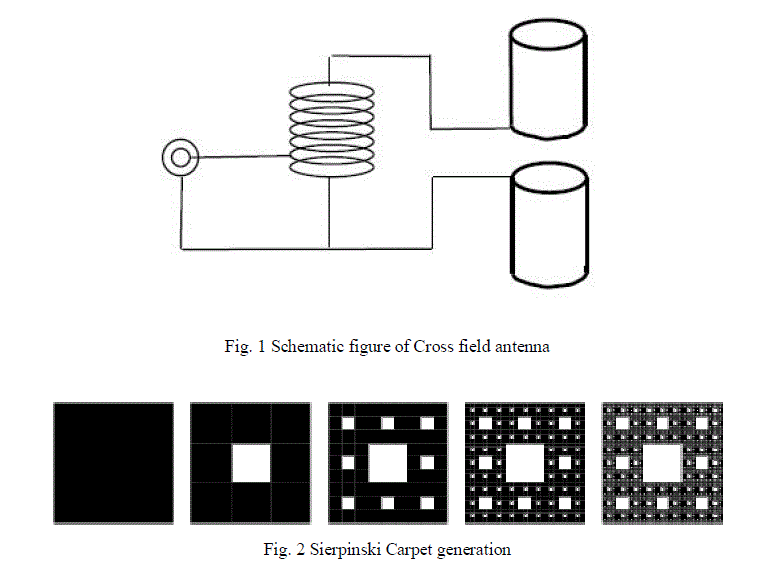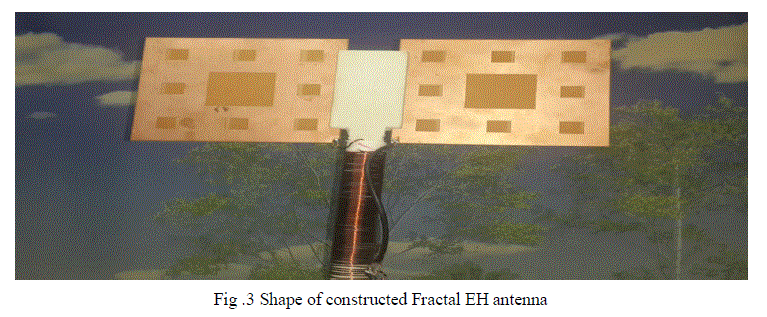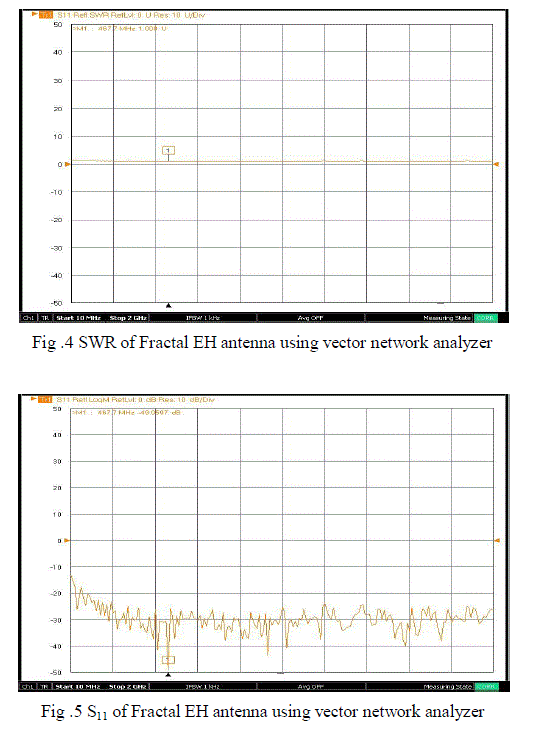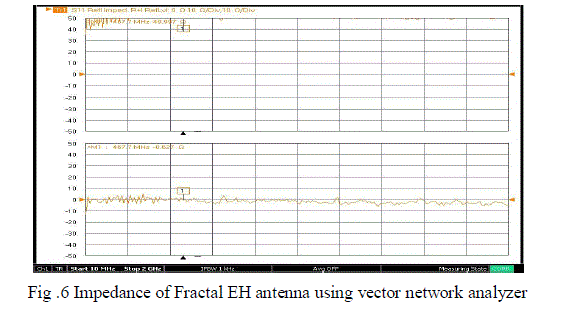ISSN ONLINE(2278-8875) PRINT (2320-3765)
ISSN ONLINE(2278-8875) PRINT (2320-3765)
Amer Basim Shaalan
|
| Related article at Pubmed, Scholar Google |
Visit for more related articles at International Journal of Advanced Research in Electrical, Electronics and Instrumentation Engineering
The main concept of Cross Field Antenna is getting phase shift between electric fields of the two cylinders of the antenna equals to 90 degrees. This is done by connecting a coil to the antenna circuit. The objective of doing this is to get rid of near field region and make far field region starting from antenna surface. Fractal shape antennas have many characteristics that not find in classical antennas. Among them is, multiband and wide band behaviour, antenna size is not depend on the operating frequency and easy matching of the antenna circuit. Here, combination of cross field antenna and fractal antenna is done; to get fractal shape cross field antenna. The proposed fractal shape is Sierpinski Carpet. Fractal shape cross field antenna has attracted wide band behaviour and self-tuning.
Keywords |
| Cross field antenna, EH antenna, Fractal antenna, Sierpinski Carpet, Poynting vector. |
I.INTRODUCTION |
| Field set up by any radiating system can be divided into two components: the induction field and the radiation field. The induction field is observed in near field area; the energy associated with it pulsates back and forth between the radiator and near-by space. At large distances the radiation field is dominant; it represents a continual flow of energy directly outward from the radiator, with a density that varies inversely with the square of the distance and, in general, depends on the direction from the source [1]. Antenna is defined as a structure that convert guided waves on a transmission line into free space waves [2]. Cross field antenna (EH) appear around 1988. It consist of two separated cylinders connected to a coil. The diameter of the coil and number of turns differs according to its frequency of operation. Schematic figure of EH antenna is shown in figure 1. Over the past few years EH antenna has been built and put into service for MW broadcasts by the Egyptian Radio and Television Union [3]. Recently, flat EH antenna designs appeared in ham's web pages. They used flat plates instead of cylinders in their designs [4]. In this paper new shape of EH antenna is proposed. Shape of antenna is utilized from fractal geometry. EH antenna with fractal shape exhibit new features not find in previous designs. |
II. LITERATURE SURVEY |
| Antenna researches has great amount of attention in electromagnetism field. Many designs of wire and microstrip antennas have published in the past years [5, 6]. Antennas with fractal shapes have been very useful tools to solve two of the limitations of classical antennas, the single band performance and the dependence of antenna’s size on the operating frequency. The first one who worked in this field was Dr.Nathan Cohen, professor at the Applied Science and Telecommunication department at Boston University. He published his first article “Fractal Antennas” in 1995, describing fractal antennas and their properties [7]. Few months later, Dr.Carles Puente at University of Catalonia, Barcelona in Spain published papers about fractal antennas [8]. His work focused on multiband behavior of fractal antennas. Fractal electrodynamics is a research area connecting the fractal geometry and electromagnetic theory, the term was coined by Dr. Dwight L. Jaggard, professor at the Electrical Engineering department at Philadelphia University. He was interested in scattering and diffraction properties of fractal bodies. Dr. Doglas H.Werner at Pennsylvania University has many publications about fractal antenna arrays, and there are others who wrote in this field [9]. Recently, EH antenna systems have take place in ham's web pages [4]. EH antenna systems need more investigation and researches to get more understanding of their work. |
III.THEORY |
| The main aim of EH antenna is to synthesis poynting vector from separate sources of electric and magnetic fields. Poynting vector created when electric and magnetic fields are in time-phase, this is done in far field region of classical antennas. In EH antenna a network circuit is used to make a 90o phase shift between voltages (electric field) of two cylinders (plates) and make electric and magnetic fields in time-phase at the body of antenna. Using this technique enable us to get rid of near field region. Wave propagation at antenna surface occurs. In other words, we move the radiated power production from far field region to near field region. Maxwell fourth equation states that: |
| It indicates that a magnetic field is created from either a charge current J or a displacement current D or from both J and D together. The magnetic field created from time varying D will be in phase with electric field of the other cylinder (plate) and creating poynting vector field. |
IV.FRACTAL SHAPE GENERATION |
| Second iteration of Sierpinski carpet is used in the new design of fractal cross-field antenna. Starting shape of Sierpinski is square. Dividing the square into nine squares, each of them equals third area of the original one. Removing the middle square, one get the first iteration of Sierpinski carpet. This process is applied to each new square to get higher iterations of this shape [10]. The generating process of Sierpinski carpet is shown in figure 2. |
V.RESULTS AND DISCUSSION |
| In this paper Sierpinski Carpet fractal shape EH antenna is proposed. Fractal shape is etched on FR4 substrate of dimensions 180 mm X 180 mm and thickness 1.5 mm. substrate has relative permittivity 4.4. Additional coil of 92 turns is connected to the antenna to achieve 90-degree phase difference between the plates. The coil diameter is 2 mm. The constructed antenna is shown in figure 3. |
 |
 |
| Measurement is done by using vector network analyzer. Matching properties represented by SWR and S11 is shown in figures 4-5. |
 |
| From these figures we can see the antenna is resonates at wide frequency band (10 Mhz – 2 Ghz). Impedance of the antenna is shown in figure 6. |
 |
| It is obvious that the fractal shape of antenna exhibit it the characteristics of wide band operating and self-tuning. |
VI.CONCLUSION |
| Fractal shape cross field (EH) antenna first proposed. Single band operation and difficulties of tuning EH antenna has been overcome by designing these antennas with fractal shapes. We get small size, high power radiation, wide band and self tuning fractal EH antenna. Using flat plate instead of cylinders in EH antenna shape makes it easy and low cost of fabrication. |
References |
|